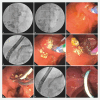Assessment of pancreatic ductal stone density on non-contrast computed tomography for predicting the outcome of extracorporeal shock wave lithotripsy
- PMID: 38420153
- PMCID: PMC10901651
- DOI: 10.1055/a-2226-1464
Assessment of pancreatic ductal stone density on non-contrast computed tomography for predicting the outcome of extracorporeal shock wave lithotripsy
Abstract
Background and study aims The utility of stone density at non-contrast computed tomography (NCCT) for predicting the effectiveness of extracorporeal shock wave lithotripsy (ESWL) in chronic calcific pancreatitis (CCP) is relatively unexplored. Patients and methods This was a prospective observational study of patients with CCP. Hounsfield units (HU) were determined for the largest pancreatic ductal stone during pretreatment NCCT. All patients underwent ESWL until the largest stone was fragmented to <3mm, followed by endoscopic retrograde cholangiopancreatography (ERCP) for stone extraction. The predictive factors following ESWL for successful stone extraction were studied and the receiver operating characteristic (ROC) curve determined the HU optimal cut-point. Results Eighty-two patients with a median (interquartile range) age of 36 years (range, 29-55); majority male 45 (54.9%), were included. Idiopathic CCP was noted in 78 patients (95.1%). The median stone density (SD) was 1095 HU (range, 860.7-1260.7) and the number of ESWL sessions was 2 (range, 2-3). Complete stone removal at index ERCP was achieved in 55 patients (67.1%). Those with partial clearance (n=27) needed a repeat ERCP, which was successful in 26 (96.3%); one patient (3.7%) underwent surgery. There was a significant, positive correlation between number of ESWL sessions and SD (r=0.797; P <0.001). On bivariate analysis, SD and the number of ESWL sessions revealed a significant association with complete ductal clearance. The optimal cut-point for complete stone removal by the ROC curve was 1106.5 HU (Youden index 0.726), with a sensitivity of 93% and a specificity of 80%. Conclusions The SD is a significant predictor of ESWL success followed by ductal clearance at ERCP, and <1106.5 HU is a predictor of good candidates for ESWL therapy.
Keywords: Pancreatobiliary (ERCP/PTCD); Stones; Strictures.
The Author(s). This is an open access article published by Thieme under the terms of the Creative Commons Attribution-NonDerivative-NonCommercial-License, permitting copying and reproduction so long as the original work is given appropriate credit. Contents may not be used for commercial purposes, or adapted, remixed, transformed or built upon. (https://creativecommons.org/licenses/by-nc-nd/4.0/).
Conflict of interest statement
Conflict of Interest The authors declare that they have no conflict of interest.
Figures



Similar articles
-
A 970 Hounsfield units (HU) threshold of kidney stone density on non-contrast computed tomography (NCCT) improves patients' selection for extracorporeal shockwave lithotripsy (ESWL): evidence from a prospective study.BJU Int. 2012 Dec;110(11 Pt B):E438-42. doi: 10.1111/j.1464-410X.2012.10964.x. Epub 2012 Feb 28. BJU Int. 2012. PMID: 22372937
-
The success of extracorporeal shock-wave lithotripsy based on the stone-attenuation value from non-contrast computed tomography.Arab J Urol. 2014 Jun;12(2):155-61. doi: 10.1016/j.aju.2014.01.002. Epub 2014 Feb 16. Arab J Urol. 2014. PMID: 26019941 Free PMC article.
-
Noncontrast computed tomography factors predictive of extracorporeal shock wave lithotripsy outcomes in patients with pancreatic duct stones.Abdom Radiol (NY). 2018 Dec;43(12):3367-3373. doi: 10.1007/s00261-018-1639-4. Abdom Radiol (NY). 2018. PMID: 29766227 Free PMC article.
-
Multiple main pancreatic duct stones in tropical pancreatitis: safe clearance with extracorporeal shockwave lithotripsy.J Gastroenterol Hepatol. 2006 Oct;21(10):1514-8. doi: 10.1111/j.1440-1746.2006.04224.x. J Gastroenterol Hepatol. 2006. PMID: 16928210 Review.
-
The role of extracorporeal shock wave lithotripsy in the treatment of chronic pancreatitis.Acta Gastroenterol Belg. 2021 Oct-Dec;84(4):620-626. doi: 10.51821/84.4.027. Acta Gastroenterol Belg. 2021. PMID: 34965044 Review.
Cited by
-
Comparison of Efficacy and Safety of Endoscopic Retrograde Cholangiopancreatography in Choledocholithiasis Patients at Different Age Groups: A Meta-Analysis.Turk J Gastroenterol. 2025 Jan 13;36(6):398-407. doi: 10.5152/tjg.2025.24003. Turk J Gastroenterol. 2025. PMID: 39840862 Free PMC article.
References
LinkOut - more resources
Full Text Sources

